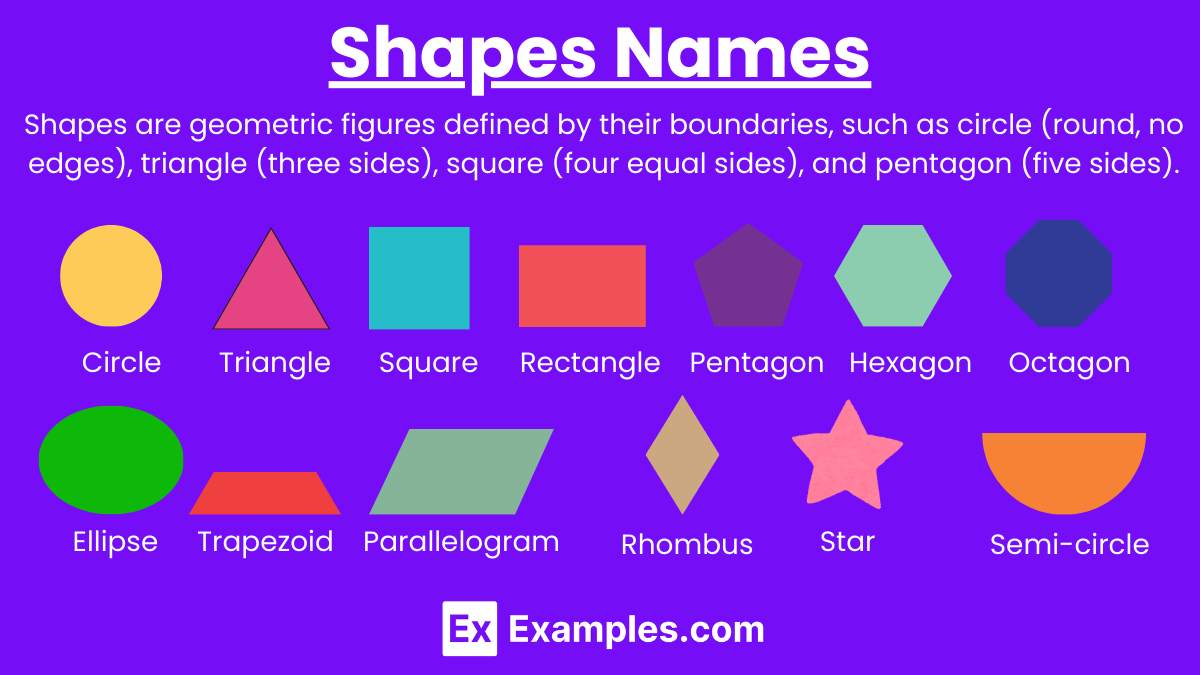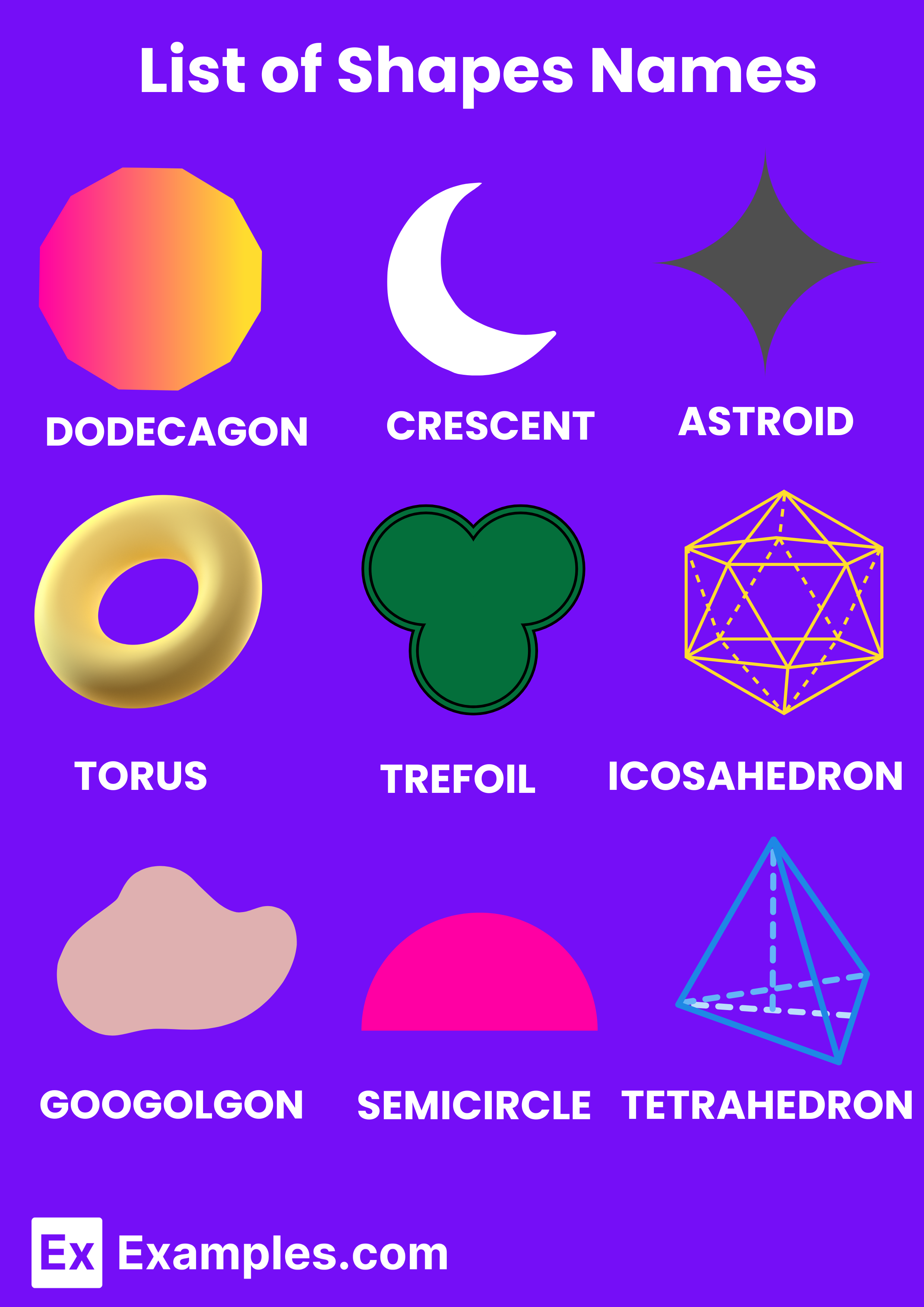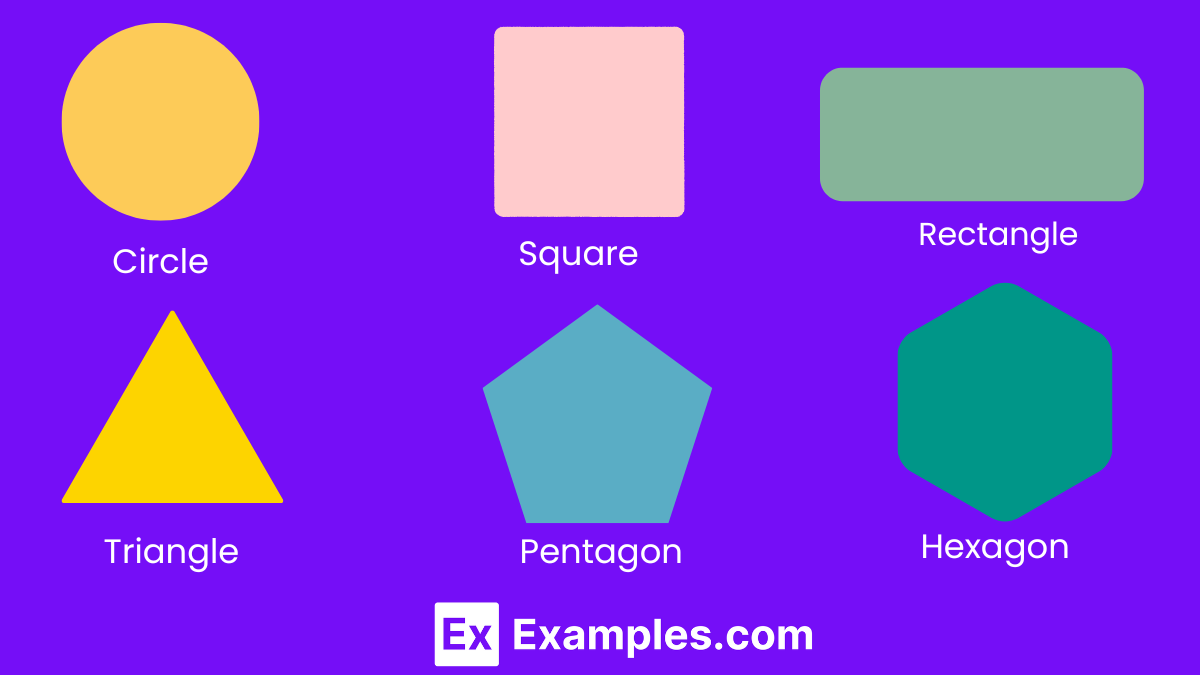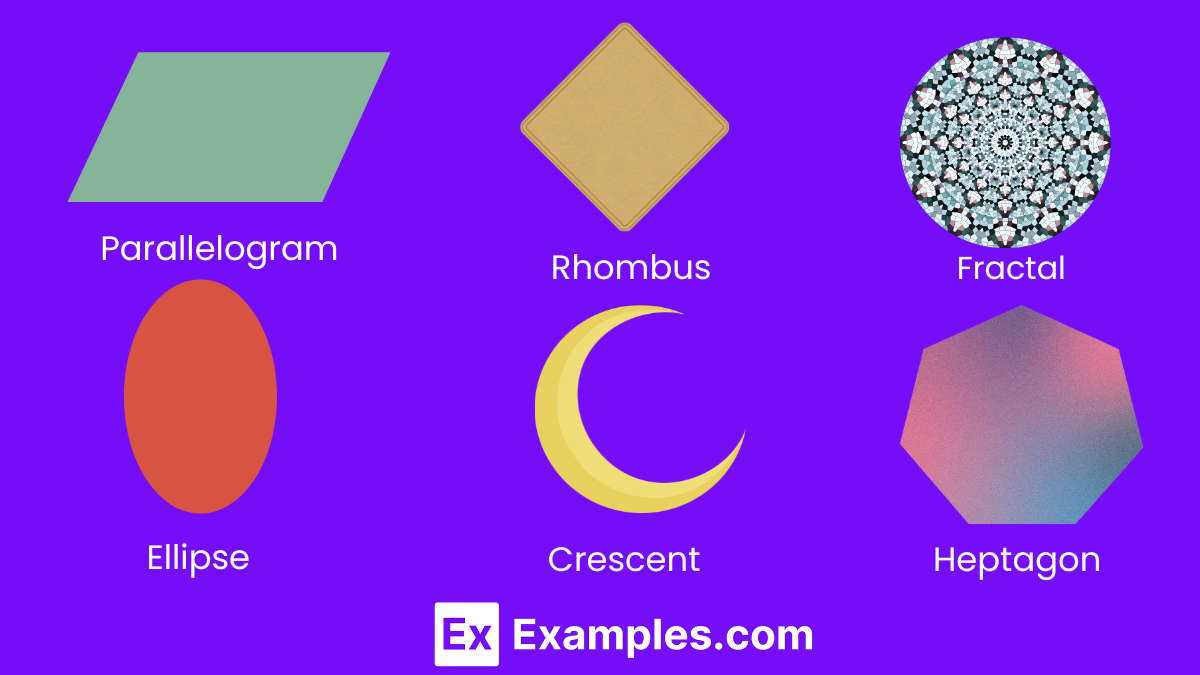Shape Names: 50+ List, Meaning, Types, PDF
Embark on a captivating journey through the world of geometry with our comprehensive guide to shape names. From the fundamental circles and squares to the more intricate polygons and polyhedra, this exploration delves into the diverse universe of shapes that form the foundation of both natural and man-made structures. Ideal for educators, students, and design aficionados, our guide illuminates the language of shapes, enriching your understanding and appreciation of the geometric patterns that weave through our daily lives.
Download List of Shapes Names - PDF
List of Shapes Names
Dive into the fascinating world of geometry with our extensive list of shape names. From the basic circles and squares to the complex dodecagons and icosahedrons, each shape offers a unique perspective on the spatial relationships that define our visual and physical world. Understanding these shapes enriches our comprehension of mathematical principles, architectural designs, and artistic compositions, making this knowledge invaluable for students, designers, architects, and anyone intrigued by the beauty and structure of forms.
| Circle | Sphere | Dodecagon | Annulus |
| Square | Cube | Hendecagon | Crescent |
| Triangle | Cylinder | Nonagon | Lune |
| Rectangle | Cone | Heptagon | Reuleaux Triangle |
| Pentagon | Pyramid | Decagon | Astroid |
| Hexagon | Torus | Tetradecagon | Gnomon |
| Heptagon | Prism | Octadecagon | Trefoil |
| Octagon | Dodecahedron | Enneadecagon | Heart |
| Nonagon | Icosahedron | Icosagon | Ellipse |
| Decagon | Octahedron | Triacontagon | Parallelogram |
| Undecagon | Tetrahedron | Hexacontagon | Rhombus |
| Dodecagon | Hexahedron | Heptacontagon | Trapezoid |
| Tridecagon | Heptahedron | Octacontagon | Kite |
| Tetradecagon | Octahedron | Enneacontagon | Scalene Triangle |
| Pentadecagon | Enneahedron | Hectogon | Isosceles Triangle |
| Hexadecagon | Decahedron | Chiliagon | Equilateral Triangle |
| Heptadecagon | Hendecahedron | Myriagon | Right Triangle |
| Octadecagon | Dodecahedron | Megagon | Semicircle |
| Enneadecagon | Triskaidecahedron | Googolgon | Sector |
| Icosagon | Tetrakaidecahedron | Gigagon | Segment |
Different Types of Shapes
1. 2D (Two-Dimensional) Shapes
Dive into the plane of 2D shapes, where length meets width to create an array of flat figures. From the simplicity of circles to the complexity of polygons, 2D shapes form the basis of geometric learning and design, offering endless possibilities for creativity and analysis in classrooms and beyond.
- Circle: A round shape with all points equidistant from the center.
- Square: Four equal sides with four right angles.
- Rectangle: Opposite sides are equal with four right angles.
- Triangle: A three-sided polygon with three angles.
- Pentagon: A five-sided polygon with five angles.
- Hexagon: A six-sided polygon with six angles.
- Heptagon: A seven-sided polygon with seven angles.
- Octagon: An eight-sided polygon with eight angles.
- Nonagon: A nine-sided polygon with nine angles.
- Decagon: A ten-sided polygon with ten angles.
2. 3D (Three-Dimensional) Shapes
Step into the realm of 3D shapes where depth adds a new dimension to the flat world of 2D figures. These shapes not only outline the structure of objects but also teach volume, surface area, and spatial reasoning, making them vital in mathematical and real-world applications.
- Sphere: A perfectly round 3D shape like a ball.
- Cube: Six equal square faces forming a box.
- Cylinder: Circular bases connected by a curved surface.
- Cone: A shape with a circular base tapering to a point.
- Pyramid: A solid object with a polygon base and triangular sides.
- Prism: A solid with two parallel, congruent faces.
- Torus: A doughnut-shaped surface generated by a circle.
- Ellipsoid: A 3D shape resembling an elongated sphere.
- Octahedron: A polyhedron with eight faces.
- Dodecahedron: A polyhedron with twelve flat faces.
3. Geometric Shapes
Explore the precision and symmetry of Geometric shapes, the cornerstone of mathematical and design principles. These shapes, defined by clear rules and formulas, are essential for constructing and understanding complex structures, making them a fundamental aspect of education and engineering.
- Parallelogram: Opposite sides are parallel and equal.
- Rhombus: An equilateral quadrilateral, essentially a diamond shape.
- Trapezoid: A four-sided figure with at least one set of parallel sides.
- Kite: A quadrilateral with two distinct pairs of adjacent sides that are equal.
- Ellipse: A circle stretched along one axis.
- Annulus: A ring-shaped object, the region between two concentric circles.
- Heptagon (Septagon): A heptagon is a polygon with seven sides and seven angles. Its interior angles sum up to 900 degrees.
- Crescent: A shape resembling a curved moon, often symbolizing growth and transformation
- Fractal: A complex geometric shape that looks the same at every scale.
- Tesseract: A four-dimensional analog of a cube.
4. Organic Shapes
Immerse yourself in the fluidity of Organic shapes, inspired by nature and freeform patterns. Unlike their geometric counterparts, these shapes are irregular, curvilinear, and often asymmetrical, mirroring the spontaneity and diversity of the natural world, making them a rich resource for creative expression.
- Leaf: The green, flat structure of plants.
- Pebble: Smooth, rounded stones found on beaches and rivers.
- Cloud: Wispy formations in the sky.
- Tree: Structures with a trunk and branches.
- Flower: The reproductive structure of flowering plants.
- Lake: A large body of water surrounded by land.
- Animal: Shapes resembling various animals.
- Mountain: Massive landforms that rise above the surrounding terrain.
- River: Curving waterways flowing to a sea or lake.
- Wave: Shapes resembling the undulating form of water waves.
5. Abstract Shapes
Delve into the realm of Abstract shapes, where imagination transcends physical boundaries. These shapes often lack a clear definition, evoking emotion and thought through unconventional forms. They are pivotal in art, design, and symbolic representation, challenging perceptions and encouraging creative interpretation.
- Spiral: A curve that winds around a fixed center point.
- Loop: A shape produced by a curve that bends around and crosses itself.
- Swirl: A shape resembling a twist or whirl.
- Blob: An irregular, amoeba-like shape.
- Polygon: A closed plane figure with three or more sides.
- Möbius Strip: A surface with only one side and one boundary.
- Klein Bottle: A non-orientable surface with no identifiable inner and outer sides.
- Mandala: A geometric configuration of symbols with a concentric structure.
- Labyrinth: Complex, branching pathways in which it is difficult to find the exit.
- Fractal: A complex geometric shape that looks the same at every scale.
What is the difference between regular and irregular shapes?
Regular shapes are defined by their uniformity and symmetry, making them easier to identify and calculate, while irregular shapes offer more diversity in form and complexity, mirroring the variability found in the natural world.
| Feature | Regular Shapes | Irregular Shapes |
|---|---|---|
| Sides | All sides are of equal length. | Sides can be of varying lengths. |
| Angles | All interior angles are equal. | Interior angles can vary. |
| Symmetry | Regular shapes are always symmetrical. | Irregular shapes may or may not be symmetrical. |
| Examples | Equilateral triangle, square, regular pentagon, regular hexagon. | Scalene triangle, rectangle (non-square), irregular polygons. |
| Definition | A shape with all sides and angles equal. | A shape with sides and angles that are not all equal. |
| Predictability | Regular shapes have a predictable structure and are easier to study. | Irregular shapes have a less predictable structure and can be more complex to analyze. |
| Tiling | Can tile a plane without gaps or overlaps using congruent copies. | Cannot tile a plane without gaps or overlaps using congruent copies. |
| Mathematical Calculation | Easier to calculate area and perimeter due to uniformity. | Calculating area and perimeter can be more complex. |
| Natural Occurrence | Less common in nature due to their perfect symmetry. | More common in nature, as natural forms tend to be varied. |
How do you identify open and closed shapes?
Identifying open and closed shapes involves understanding their basic properties:
Open Shapes:
- Definition: Open shapes do not form a complete path; they have at least one “end” that doesn’t connect back to the starting point.
- Examples: A line or a curve that doesn’t join back to its starting point.
- Characteristics:
- Ends do not meet.
- Cannot contain an area within them.
- Often used in diagrams or sketches to represent partial or incomplete boundaries.
Closed Shapes:
- Definition: Closed shapes form a complete path with all endpoints connected, enclosing a space.
- Examples: Circles, triangles, squares, and any polygon.
- Characteristics:
- Ends meet to enclose a space.
- Can contain an area within their boundaries.
- Commonly used to represent complete, self-contained boundaries or areas.
The sum of the interior angles of a polygon can be calculated using the formula: (n−2)×180∘, where is the number of sides (or vertices). This formula highlights the direct relationship between the number of sides a shape has, its vertices, and the total measure of its internal angles.
Here’s a table illustrating the relationship between a shape’s sides, vertices, and the sum of its interior angles:
| Shape Type | Number of Sides (n) | Number of Vertices | Sum of Interior Angles |
|---|---|---|---|
| Triangle | 3 | 3 | 180∘ |
| Quadrilateral | 4 | 4 | 360∘ |
| Pentagon | 5 | 5 | 540∘ |
| Hexagon | 6 | 6 | 720∘ |
| Heptagon | 7 | 7 | 900∘ |
| Octagon | 8 | 8 | 1080∘ |
| Nonagon | 9 | 9 | 1260∘ |
| Decagon | 10 | 10 | 1440∘ |
Why is Teaching Shapes So Important?
Teaching shapes is crucial for several reasons, as it lays the foundation for various essential skills and knowledge:
- Cognitive Development: Recognizing and categorizing shapes helps develop cognitive skills in children, enhancing their ability to observe, compare, and contrast different characteristics.
- Mathematical Foundation: Shapes are the basics of geometry. Understanding shapes prepares students for more complex mathematical concepts, such as area, perimeter, volume, and spatial reasoning.
- Problem-Solving Skills: Working with shapes enhances problem-solving and critical thinking skills. It encourages children to make connections and understand the relationships between different shapes and their properties.
- Language Skills: Learning about shapes also helps in language development. Children learn new words and terms, improving their descriptive language skills when they talk about different shapes and their attributes.
- Creativity and Art: Shapes are fundamental to art and design. Recognizing and understanding shapes is crucial for drawing, painting, and creating art, fostering creativity and artistic skills.
- Everyday Life Skills: Shapes are everywhere. Teaching shapes helps children understand and interpret the world around them, from navigating spaces to recognizing symbols and signs.
- Motor Skills: Activities involving shapes, like drawing, cutting, and assembling, enhance fine motor skills and hand-eye coordination.
List of Shapes Names starting with A-Z
Shapes Starting with A
| Annulus | Arrow |
| Astroid | Antiprism |
| Arch | Apollonian Gasket |
| Arrowhead | Auricula |
| Acute Triangle | Aztec Diamond |
Shapes Starting with B
| Box | Butterfly Curve |
| Barrel | Bicone |
| Brick | Bifolium |
| Bell Curve | Bipyramid |
| Bowtie | Bilunabirotunda |
Shapes Starting with C
| Shape Name | Shape Name |
|---|---|
| Circle | Crescent |
| Cube | Cylinder |
| Cone | Cuboid |
| Crescent Moon | Cycloid |
| Cross | Cusp |
Shapes Starting with D
| Decagon | Deltoid |
| Diamond | Dodecahedron |
| Disk | Dodecagram |
| Dome | Diabolo |
| Dumbbell | Dendrite |
Shapes Starting with E
| Ellipse | Enneagon |
| Ellipsoid | Enneadecagon |
| Egg | Equilateral Triangle |
| Echidnahedron | Excavated Dodecahedron |
| Enneagram |
Shapes Starting with F
| Frustum | Flabellum |
| Fusiform | Folium |
| Fibonacci Spiral | Filled Star Polygon |
| Fleur-de-lis | Fusilli |
| Fish | Ferris Wheel |
Shapes Starting with G
| Shape Name | Shape Name |
|---|---|
| Goblet | Gyroid |
| Gasket | Globe |
| Gear | Glome |
| Gaussian Curve | Gnomon |
| Great Dodecahedron | Great Icosahedron |
Shapes Starting with H
| Heart | Hexagon |
| Hemisphere | Heptagon |
| Hexagram | Horseshoe |
| Hyperboloid | Helicoid |
| Hypotrochoid | Honeycomb |
Shapes Starting with I
| Icosahedron | Icosagon |
| Irregular Polygon | Involute |
| Isosceles Triangle | Isotoxal Star |
| Isosceles Trapezoid | Isohedron |
| Inellipse | Inverted Curve |
Shapes Starting with J
| Javelin | Jewel |
| Julia Set |
Shapes Starting with K
| Kite | Knot |
| Klee Irregular | Koch Snowflake |
| Kepler Triangle | Kummer Surface |
Shapes Starting with L
| Lune | Lemniscate |
| Lozenge | Lenticular |
| Limaçon | Logarithmic Spiral |
| Lens | Lissajous Curve |
| Labyrinth | Lunula |
Shapes Starting with M
| Mobius Strip | Mandelbrot Set |
| Moon | Mosaic |
| Multifoil | Macaroni |
| Miter | Meander |
| Mace | Merkaba |
Shapes Starting with N
| Nonagon | Nephroid |
| Node | Nullagon |
| Nonahedron | Nanogon |
| Nub | Navel |
Shapes Starting with O
| Oval | Octagon |
| Ovoid | Orb |
| Octahedron | Orthobicupola |
| Octagram | Ogee |
| Obelisk | Oloid |
Shapes Starting with P
| Pentagon | Pyramid |
| Prism | Parallelogram |
| Pentagram | Prolate |
| Pear | Polyhedron |
| Pappus Chain | Pseudosphere |
Shapes Starting with Q
| Quadrilateral | Quatrefoil |
| Quintic Curve | Quadric Surface |
| Quasicrystal | Quadrangle |
| Quincunx | Quindecagon |
Shapes Starting with R
| Rectangle | Rhombus |
| Rhomboid | Reuleaux Triangle |
| Rose Curve | Rectangular Prism |
| Radiolarian | Rounded Rectangle |
| Ring | Ribbed Vault |
Shapes Starting with S
| Square | Sphere |
| Spiral | Star |
| Semicircle | Scalene Triangle |
| Spheroid | Superellipse |
| Stadium | Stellated Polygon |
| Swastika | Saddle Surface |
Shapes Starting with T
| Triangle | Torus |
| Trapezoid | Tetrahedron |
| Tesseract | Triskelion |
| Trefoil | Toroid |
| Triquetra | Twisted Prism |
| Truncated Cone | Trihexagonal Tiling |
Shapes Starting with U
| Shape Name | Shape Name |
|---|---|
| Unea | Uloco |
Shapes Starting with V
| Venn Diagram | Vesica Piscis |
| Volute | Vertex |
Shapes Starting with W
| Wave | Wedge |
| Whorl | Windmill |
| Weaire–Phelan Structure | Wing |
Shapes Starting with X
| Xylophone Bar |
Shapes Starting with Y
| Yarn | Yotta |
Shapes Starting with Z
| Zigzag | Zonohedron |
| Ziggurat | Zero |
In conclusion , exploring the names of shapes opens a window to a world where geometry and creativity intersect, enriching our understanding of the space and structures around us. From the basic circles and squares to the complex polygons and solids, each shape offers a unique perspective, fostering a deep appreciation for the mathematical beauty that constructs our visual and physical world.








